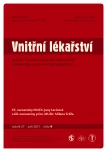The importance of antihypertensive therapy in subclinical brain damage
Authors:
M. Souček; I. Řiháček; P. Fráňa; M. Plachý
Authors‘ workplace:
II. interní klinika Lékařské fakulty MU a FN u sv. Anny v Brně, přednosta prof. MUDr. Miroslav Souček, CSc.
Published in:
Vnitř Lék 2011; 57(9): 751-754
Category:
65th birthday Mudr. Jany Laciné and and 60th birthday Milana Tržila
Overview
Older patients are often affected by impaired cognitive function and high blood pressure. Damage to microcirculation of the brain is closely related to changes in large vessels. High blood pressure and vascular stiffness might lead to a damage in microcirculation of the brain and, consequently, to worsening of the patient’s cognitive function and dementia. We discuss early diagnosis of subclinical brain damage using magnetic resonance and its preventive management with antihypertensive therapy.
Key words:
hypertension – cognitive function – dementia – brain microcirculation – prevention of subclinical brain damage
Sources
1. Rocca WA, Hofman A, Brayne C et al. The prevalence of vascular dementia in Europe: facts and fragments from 1980–1990 studies. EURODEM – Prevalence Research Group. Ann Neurol 1991; 30: 817–824.
2. Melzer D, Ely M, Brayne C. Cognitive impairment in elderly people: population based estimate of the future in England, Scotland, and Wales. BMJ 1997; 315: 462.
3. Mancia G, Laurent S, Agabiti-Rosei E et al. European Society of Hypertension. Reappraisal of European guidelines on hypertension management: a European Society of Hypertension Task Force document. J Hypertens 2009; 27: 2121–2158.
4. Scuteri A, Najjar SS, Orru’ M et al. Age-and gender-specific awareness, treatment, and control of cardiovascular risk factors and subclinical vascular lesions in a founder population: the SardiNIA Study. Nutr Metab Cardiovasc Dis 2009; 19: 532–541.
5. Laurent S, Boutouyrie P, Asmar R et al. Aortic stiffness is an independent predictor of all-cause and cardiovascular mortality in hypertensive patients. Hypertension 2001; 37: 1236–1241.
6. Silvestrini M, Gobi B, Pasqualetti P et al. Carotid atherosclerosis and cognitive decline in patients with Alzheimer’s disease. Neurobiol Aging 2009; 30: 1177–1183.
7. Hanon O, Haulon S, Lenoir H et al. Relationship between stiffness and cognitive function in elderly subjects with complaints of memory loss. Stroke 2005; 36: 2193–2197.
8. Laurent S, Briet M, Boutouyrie P. Large and small artrery gross-talk and recent morbidity-mortality trials in hypertension. Hypertension 2009; 54: 388–392.
9. Safar ME, Lacolley P. Disturbance of macro- and microcirculation: relations with pulse pressure and cardiac organ damage. Am J Physiol Heart Circ Physiol 2007; 293: H1–H7.
10. O’Rourke MF, Safar ME. Relationship between aortic stiffening and microvascular disease in brain and kidney: cause and logic to therapy. Hypertension 2005; 46: 200–204.
11. Farasat SM, Morrell CH, Scuteri A et al. Pulse pressure is inversely related to aortic root diameter implications for the pathogenesis of systolic hypertension. Hypertension 2008; 51: 196–202.
12. Longstreth WT Jr, Manolio TA, Arnold A et al. Clinical correlates of white matter findings on cranial magnetic resonance imaging of 3 301 elderly people: the cardiovascular health study. Stroke 1996; 27: 1274–1282.
13. Vermeer SE, Longstreth WT Jr, Koudstaal PJ. Silent brain infarcts: a systematic review. Lancet Neurol 2007; 6: 611–619.
14. de Leeuw FE, De Groot JC, Oudkerk M et al. Hypertension and cerebral white matter lesions in a prospective cohort study. Brain 2002; 125: 765–772.
15. Havlik RJ, Foley DJ, Sayer B et al. Variability in midlife systolic blood pressure is related to late-life brain white matter lesions: the Honolulu-Asia Aging study. Stroke 2002; 33: 26–33.
16. Vermeer SE, Prins ND, den Heijer T et al. Silent brain infarcts and the risk of dementia and cognitive decline. N Engl J Med 2003; 348: 1215–1222.
17. Prins ND, Van Dijk EJ, den Heijer T et al. Cerebral white matter lesions and the risk of dementia. Arch Neurol 2004; 61: 1531–1534.
18. Godin O, Dufouil C, Maillard P et al. White matter lesion as a predictor of depression in the elderly: The 3C-Dijon study. Biol Psychiatry 2008; 63: 663–669.
19. Dufouil C, Gordin O, Chalmers J et al. PROGRESS MRI Substudy Investigators. Severe cerebral white matter hyperintensities predict severe cognitive decline in patients with cerebrovascular disease history. Stroke 2009; 40: 2219–2221.
20. Snowdon DA, Greiner LH, Mortimer LA et al. Brain infarction and the clinical expression of Alzheimer disease: the Nun study. JAMA 1997; 277: 813–817.
21. Buyck JF, Dufouil C, Mazoyer B et al. Cerebral white matter lesions are associated with the risk of stroke but not with other vascular events. The 3c-Dijon Study. Stroke 2009; 40: 2327–2331.
22. Kearney-Schwartz A, Rossignol P, Bracard S et al. Vascular structure and function is correlated to cognitive performance and white matter hyperintensities in older hypertensive patients with subjective memory complaints. Stroke 2009; 40: 1229–1236.
23. Henskens LH, van Oostenbrugge RJ, Kroon AA et al. Detection of silent cerebrovascular disease refines risk stratification of hypertensive patients. J Hypertens 2009; 27: 846–853.
24. Neal B, Chapman N, Chalmers J et al on behalf of the PROGRESS Collaborative Group. Cardiac outcomes in the Perindopril Protection Against Recurrent Stroke Study. J Hypertens 2002; 20 (Suppl 4): S169.
Labels
Diabetology Endocrinology Internal medicineArticle was published in
Internal Medicine

2011 Issue 9
Most read in this issue
- Proteinuria in primary care
- Prokinetic agents – their contribution to practice of gastroenterology
- Plypharmacy and drug interactions
- Thyreopathy in primary care
